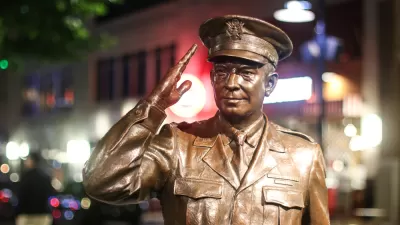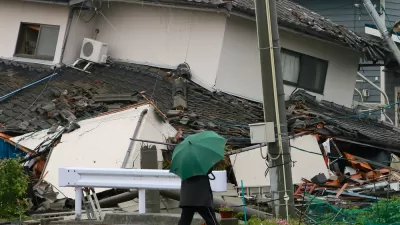In light of the recent controversy surrounding the Eisenhower Memorial in Washington DC, and observations from a recent trip to Japan, Christopher Hawthorne pens an opinion piece on memorials - the "eternally fraught corner of design practice.
In reflecting on his recent trip to Japan and future efforts to memorialize the 19,000 who perished as a result of last year's earthquake and tsunami, Hawthorne ruminates on recent memorializing processes in the United States - at the World Trade Center, to Martin Luther King Jr., and to President Eisenhower - and sees an opportunity, and need, to rethink the processes and products of memorial design.
For Hawthorne, a visit to a giant red fish-oil tank, mangled by the tsunami and sitting in a median in Ishinomaki, Japan, that he describes as an "odd piece of apocalyptic detritus", provides a potent symbol of the disaster.
It reflecting on "how overpriced and underwhelming so many traditional memorials have turned out to be in recent years," Hawthorne finds inspiration from his Japanese experience. "By contrast, the mangled red can in Ishinomaki eludes both bombast and easy readings. The way it manages to suggest two very different scales simultaneously - the quotidian scale of the supermarket shelf and the stunning strength of the tsunami - gives it some Pop art shadings and makes it even more artistically meaningful than, say, the twisted steel beams from the World Trade Center that will go on display at the Sept. 11 museum."
Also of note, on the subject of memorials, is a report by Philip Kennicott in The Washington Post on yesterday's congressional hearing on Gehry's Eisenhower Memorial design. At the hearing, Susan Eisenhower, granddaughter to the President, and representing the family, called for scrapping the current design, which she comapred to, "Communist-era decorations that honored 'Marx, Engels and Lenin.' She likened large columns that will be used to hang the metal scrims to 'missile silos,' mentioned Ho Chi Minh and Mao, and argued that Holocaust survivors were affronted by the similarity of the tapestries to the fences of Adolf Hitler's death camps."
According to Kennicott, "It's not clear whether Congress will reopen the [memorial design] process, especially given that eight of the Memorial Commission's 12 members serve in Congress. And while there has been growing momentum for revisiting the Gehry design among traditionalists and culture warriors, concern about the design hasn't coalesced into a coherent critique."
FULL STORY: Critic's Notebook: Rethinking memorials in aftermath of Japan tsunami

Alabama: Trump Terminates Settlements for Black Communities Harmed By Raw Sewage
Trump deemed the landmark civil rights agreement “illegal DEI and environmental justice policy.”

Planetizen Federal Action Tracker
A weekly monitor of how Trump’s orders and actions are impacting planners and planning in America.

The 120 Year Old Tiny Home Villages That Sheltered San Francisco’s Earthquake Refugees
More than a century ago, San Francisco mobilized to house thousands of residents displaced by the 1906 earthquake. Could their strategy offer a model for the present?

In Both Crashes and Crime, Public Transportation is Far Safer than Driving
Contrary to popular assumptions, public transportation has far lower crash and crime rates than automobile travel. For safer communities, improve and encourage transit travel.

Report: Zoning Reforms Should Complement Nashville’s Ambitious Transit Plan
Without reform, restrictive zoning codes will limit the impact of the city’s planned transit expansion and could exclude some of the residents who depend on transit the most.

Judge Orders Release of Frozen IRA, IIJA Funding
The decision is a victory for environmental groups who charged that freezing funds for critical infrastructure and disaster response programs caused “real and irreparable harm” to communities.
Urban Design for Planners 1: Software Tools
This six-course series explores essential urban design concepts using open source software and equips planners with the tools they need to participate fully in the urban design process.
Planning for Universal Design
Learn the tools for implementing Universal Design in planning regulations.
Clanton & Associates, Inc.
Jessamine County Fiscal Court
Institute for Housing and Urban Development Studies (IHS)
City of Grandview
Harvard GSD Executive Education
Toledo-Lucas County Plan Commissions
Salt Lake City
NYU Wagner Graduate School of Public Service





























